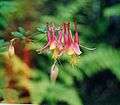Aquilegia canadensis
| Aquilegia canadensis | |
|---|---|
 | |
| Scientific classification | |
| Kingdom: | Plantae |
| (unranked): | Angiosperms |
| (unranked): | Eudicots |
| Order: | Ranunculales |
| Family: | Ranunculaceae |
| Genus: | Aquilegia |
| Species: | A. canadensis |
| Binomial name | |
| Aquilegia canadensis L. | |
Aquilegia canadensis (Canadian or Canada columbine, Eastern red columbine, Wild columbine) is an herbaceous perennial native to woodland and rocky slopes in eastern North America, prized for its red and yellow flowers. It readily hybridizes with other species in the genus Aquilegia.
Description
Height is 15–90 cm (6–35 in). Leaves are lobed and grouped in 3s, growing from the base and off the flowering stems. Flowers are 1-2 inches long and have yellow petals with a red spur and red sepals. They appear in late spring, nodding on stems above the leaves. The round end of the spur contains nectar, which is sought by butterflies and hummingbirds.
The caterpillars of Columbine Duskywing (Erynnis lucilius) feed on the leaves.
Cultivation
The plant is easily propagated from seed and blooms the second year. It is relatively long lived in the garden. It grows well in shade, and in sun with proper moisture.
The plant has gained the Royal Horticultural Society's Award of Garden Merit.[1]
The cultivar 'Little Lanterns' is half the height of the species.
Uses
Native American tribes used various parts of red columbine in herbal remedies for ailments such as headache, sore throat, fever, rash caused by poison ivy, stomatitis, kidney and urinary problems, and heart problems.[2] Native American men also rubbed crushed seeds on their hands as a love charm.[3]
Toxicity
Canada columbine contains a cyanogenic glycoside, which releases poisonous hydrogen cyanide when the plant is damaged.[4]
Distribution
USA (AL, AR, CT, DC, DE, FL, GA, IA, IL, IN, KS, KY, MA, MD, ME, MI, MN, MO, MS, NC, ND, NE, NH, NJ, NY, OH, OK, PA, RI, SC, SD, TN, TX, VA, VT, WI, WV), Canada (MB, NB, ON, QC, SK)
Wetland Indicator Status
Regions 1-5: Facultative Equally (FAC) likely to occur in wetlands or non-wetlands (estimated probability 34%-66%).
- Region 6: Facultative Wetland (FACW) Usually occurs in wetlands (estimated probability 67%-99%), but occasionally found in non-wetlands.
Gallery
-
Eastern red columbine blooms near the cave entrance at Florida Caverns State Park at Marianna, Florida
-

A swatch of columbine
-
Aquilegia canadensis in Nashville, TN. 22 April 2008.
-

Flower and seedpod
-

along Magnetawan River, Ontario
-

-

leaves
References
- ↑ "RHS Plant Selector - Aquilegia canadensis". Retrieved 7 July 2013.
- ↑ "Red Columbine" (PDF). PLANTS Database. United States Department of Agriculture Natural Resources Conservation Service. Retrieved 12 June 2016.
- ↑ "Aquilegia canadensis". NPIN: Native Plants Database. Lady Bird Johnson Wildlife Center. Retrieved 12 June 2016.
- ↑ Edible and Medicinal Plants of Minnesota and Wisconsin. Matthew Alfs. Old Theology Book House. 2001. p. 99.
External links
- "Aquilega canadensis". Flora of North America (FNA). Missouri Botanical Garden – via eFloras.org. — map
- Native Plant Identification Network
- Germplasm Resources Information Network
- US Forest Service — Celebrating Wildflowers
- Connecticut Botanical Society
- Missouri Plants
- Illinois Wildflowers
- Michigan Department of Natural Resources
- Minnesota Wildflowers
- Floridata
- 'Little Lanterns' — Paghat's Garden
- Aquilega canadensis in the CalPhotos Photo Database, University of California, Berkeley
- Kew Plant List
- IPNI Listing
